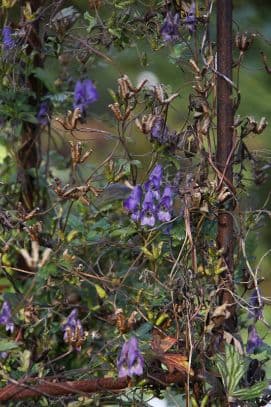Clematis Clematis 'Louise Rowe' (EL)

ABOUT
Clematis 'Louise Rowe' features a rich display of intricately patterned flowers that are the true highlight of this plant. The blossoms are a charming blend of pink and purple, presenting a delicate pastel hue. Each flower showcases a rosette shape, formed by layers of rounded petals that artfully overlap. At the center, a cluster of pale yellow stamens adds a striking contrast to the softness of the petal colors, creating an eye-catching focal point. The petals possess a velvety texture that begs to be touched, with a subtle grace that evokes a sense of romance and whimsy. As the blooms mature, they may fade slightly in color, giving the plant an enchanting, ever-evolving beauty throughout its blooming period. The foliage of Clematis 'Louise Rowe' is also noteworthy, with leaves that are deep green in color, providing a lush backdrop that allows the flowers to stand out even more prominently. When in full bloom, the plant becomes a tapestry of color, with blossoms dotting the vibrant green foliage in an elegant display. It is a plant that can add visual interest and a touch of sophistication to any garden space, attracting the admiration of gardeners and onlookers alike. Not to be overlooked is the gentle manner in which the blossoms nod in the breeze, lending a dynamic and kinetic quality to the plant's overall appearance that enhances its charm.
About this plant
 Names
NamesFamily
Ranunculaceae.
Synonyms
Clematis, Leather Flower, Virgin's Bower.
Common names
Clematis 'Louise Rowe' (EL).
 Toxicity
ToxicityTo humans
The Clematis, which encompasses the variety 'Louise Rowe,' is known to be mildly toxic to humans if ingested. All parts of the plant contain irritating glycosides, which can cause internal discomfort. If someone eats part of a Clematis, they might experience symptoms such as nausea, vomiting, diarrhea, and excessive salivation. Contact with the sap may also cause skin irritation, so it is advisable to handle the plant with care.
To pets
The Clematis plant is also toxic to pets, including cats and dogs. If a pet ingests part of a Clematis, it could experience symptoms similar to those in humans, including drooling, vomiting, and diarrhea. The plant contains glycosides which can be an irritant, potentially leading to gastrointestinal upset. It is important for pet owners to ensure that their pets do not chew on or ingest this plant to avoid these potentially harmful effects.
 Characteristics
CharacteristicsLife cycle
Perennials
Foliage type
Deciduous
Color of leaves
Green
Flower color
Pink
Height
6 feet 2 inches (1.88 meters)
Spread
3 feet (0.91 meters)
Plant type
Climber
Hardiness zones
4
Native area
Temperate regions
Benefits
 General Benefits
General Benefits- Visual Appeal: Clematis 'Louise Rowe' provides stunning large, mauve-pink flowers with a hint of purple that can add beauty to gardens and landscapes.
- Pollinator Attraction: The flowers of this clematis attract bees and butterflies, supporting local ecosystems and pollination processes.
- Versatility: Suitable for training on trellises, walls, arbors, and pergolas, it can be used in various garden designs including vertical gardening.
- Seasonal Interest: This plant offers seasonal interest throughout its blooming period, which typically extends from late spring to early summer and often has a second bloom in late summer or fall.
- Hardiness: Clematis 'Louise Rowe' is a hardy perennial that can withstand various climate zones with appropriate care and winter protection where necessary.
- Screening: When grown on structures, it can provide privacy and screen unsightly areas effectively.
- Garden Structure: The climbing habit of this clematis can add height and structure to garden beds and borders.
- Companion Planting: It pairs well with other plants, allowing for complementary gardening whereby it can share support structures with climbing roses or other vines.
 Medical Properties
Medical PropertiesThis plant is not used for medical purposes.
 Air-purifying Qualities
Air-purifying QualitiesThis plant is not specifically known for air purifying qualities.
 Other Uses
Other Uses- Clematis 'Louise Rowe' can be trained to grow over arbors, trellises, or pergolas, providing a beautiful floral canopy for shade and aesthetic appeal.
- When dried, the seed heads of this clematis can be used in floral arrangements, adding a whimsical touch to bouquets and decorations.
- This plant's climbing habit can be utilized to create living walls which serve as a natural privacy screen in gardens and outdoor spaces.
- Clematis can be planted alongside building walls to create a green facade, helping to reduce heat absorption during warm months.
- The plant can be grown in containers on balconies or patios where ground planting isn't possible, adding vertical interest and color.
- Harvested young, flexible stems of clematis can be woven into small craft items like wreaths or plant supports, demonstrating the plant's versatility.
- In photography, clematis 'Louise Rowe' can be used as a stunning natural backdrop for close-up macro photography or portraits due to its vibrant color and intricate flowers.
- Landscape designers may use clematis to soften hardscapes, subtly integrating the plant into rockeries or alongside garden paths.
- The plant can be guided over unsightly features in the garden, such as compost bins or tool sheds, to help them blend into the surroundings.
- For an educational purpose, clematis can be used in horticultural therapy programs, where participants learn to care for and cultivate plants for their well-being.
Interesting Facts
 Feng Shui
Feng ShuiThe Clematis is not used in Feng Shui practice.
 Zodiac Sign Compitability
Zodiac Sign CompitabilityThe Clematis is not used in astrology practice.
 Plant Symbolism
Plant Symbolism- Ingenuity: Clematis, including the 'Louise Rowe' variety, often symbolizes cleverness due to its ability to climb and adapt to its surroundings, finding ways to anchor and elevate itself.
- Mental Beauty: The intricate and vibrant flowers of the clematis represent the beauty of the mind, suggesting depth, intricacy, and intellectual aesthetics.
- Artistic Inspiration: Owing to its impressive blooms, clematis can symbolize inspiration, making it a muse for artists and creatives seeking to ignite their imaginative process.
 Water
WaterThe Clematis, commonly known as 'Louise Rowe,' should be watered thoroughly to keep the soil moist but not waterlogged. During the growing season, watering once a week with approximately one gallon of water per plant is typically sufficient, but this can vary depending on weather conditions and soil type. It is important to avoid overhead watering to prevent fungal diseases. In hotter, drier periods, increase the frequency of watering to ensure the root ball doesn't dry out. During the winter, reduce watering to prevent root rot, especially if the ground is frozen.
 Light
LightThe 'Louise Rowe' Clematis thrives in locations where it can receive about six hours of sunlight daily, with some afternoon shade to protect it from the hottest part of the day. A spot with morning sun and afternoon shade is ideal, ensuring that the roots remain cool while the vine gets enough light to bloom profusely. Avoid deep shade, as this will reduce flowering.
 Temperature
TemperatureThe 'Louise Rowe' Clematis prefers a temperate climate, with an ideal growing temperature range between 50 to 75 degrees Fahrenheit. It can withstand minimum winter temperatures down to around 20 degrees Fahrenheit but requires protection from severe cold. Extreme heat above 80 degrees Fahrenheit can stress the plant; ensure it has some shade during the hottest parts of the day in warmer climates.
 Pruning
PruningPrune the 'Louise Rowe' Clematis to encourage vigorous growth and to shape the plant. It belongs to pruning group 2, meaning it should be lightly pruned in early spring to remove dead or weak stems and to tidy up the plant. Cut back the remaining stems to strong buds. After the early summer blooming, you can cut back flowered stems by a third to promote a second bloom in late summer or early fall.
 Cleaning
CleaningAs needed
 Soil
SoilThe Clematis 'Louise Rowe' prefers well-draining, fertile soil rich in organic matter with a soil pH that is neutral to slightly alkaline. A mix containing two parts garden soil, one part well-rotted manure or compost, and one part pumice or perlite would be ideal to ensure proper drainage and nutrient content.
 Repotting
RepottingClematis 'Louise Rowe' should be repotted every 2 to 3 years, or when it outgrows its current container. The best time to repot is in the late winter or early spring before the onset of new growth.
 Humidity & Misting
Humidity & MistingClematis 'Louise Rowe' flourishes best at average humidity levels, ranging between 40-70%. Maintaining good air circulation around the plant is essential to prevent fungal diseases, which can occur if the humidity is too high.
 Suitable locations
Suitable locationsIndoor
Place Clematis 'Louise Rowe' by a sunny window and ensure support for climbing.
Outdoor
Plant in well-drained soil, full sun to part shade, with a climbing support.
Hardiness zone
4-9 USDA
 Life cycle
Life cycleClematis 'Louise Rowe', commonly known as Clematis, starts its life as a seed or more commonly from cuttings or nursery-grown plants. Once planted, it enters a vegetative stage, where it develops roots, stems, and leaves. As it matures, it climbs using tendrils, finding support on structures or other plants. After a period of establishment, it enters the flowering stage, producing large, showy blooms typically in late spring to early summer. Post-bloom, the plant sets seed in the form of feathery seed heads, which can be distributed by wind or animals, leading to new plants if conditions are favorable. Throughout the growing season, Clematis 'Louise Rowe' requires pruning to maintain shape and vigor, and in winter, it becomes dormant, with the cycle resuming with the return of warmer weather.
 Propogation
PropogationPropogation time
Spring to Early Summer
The Clematis 'Louise Rowe', a particularly robust and attractive variety of clematis, is most commonly propagated through softwood cuttings. This method typically takes place in early summer when the plant's new growth is just beginning to harden. Gardeners should select a healthy stem with at least three sets of leaves and cut it just below a node, approximately 3-4 inches (7.5-10 cm) in length. The leaves on the lower half of the cutting should be removed, and the cut end can be dipped in rooting hormone to encourage root development. The prepared cutting is then placed in a well-draining potting mix, ensuring the remaining leaves are above the surface. The pots should be kept in a warm area with indirect light and covered with a plastic bag to maintain humidity. Roots usually develop within a few weeks, after which the new clematis plants can eventually be transplanted outdoors.









